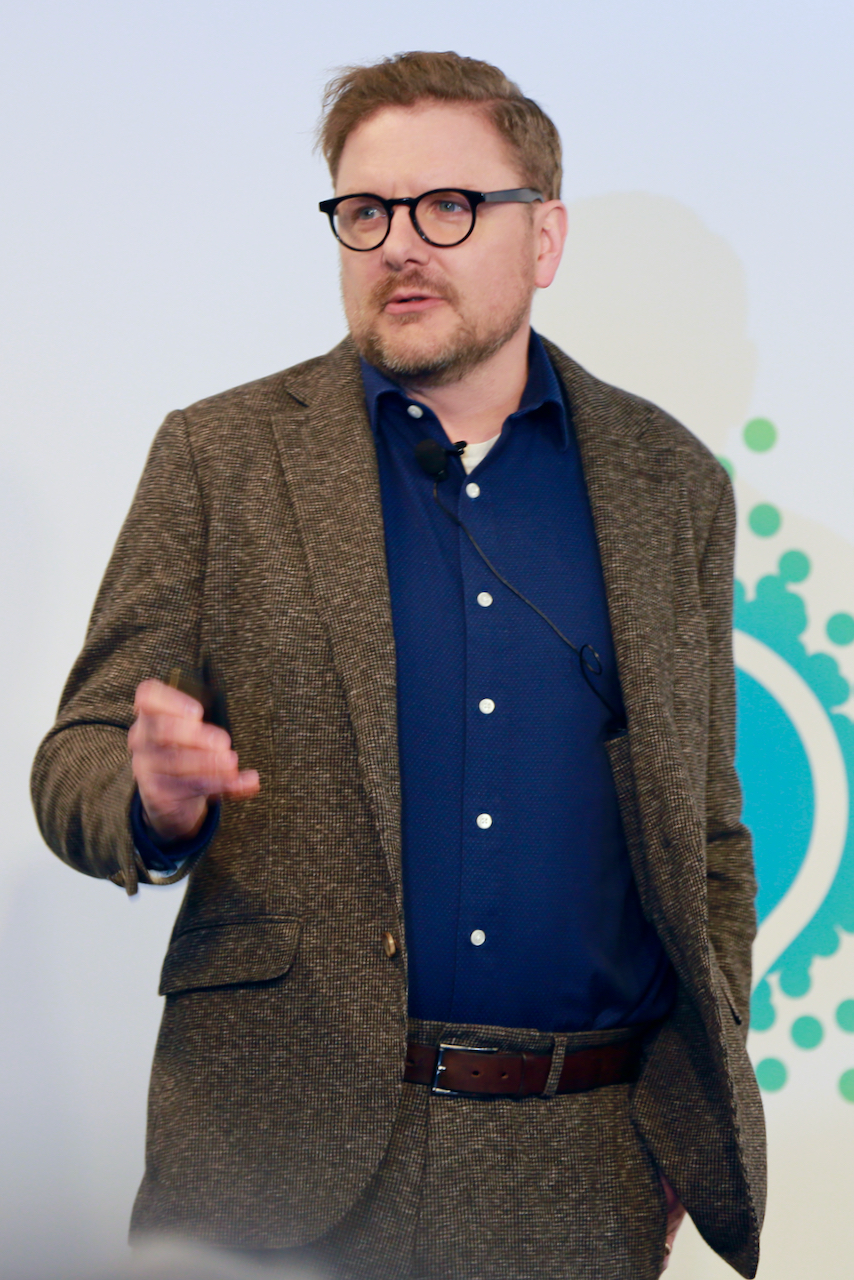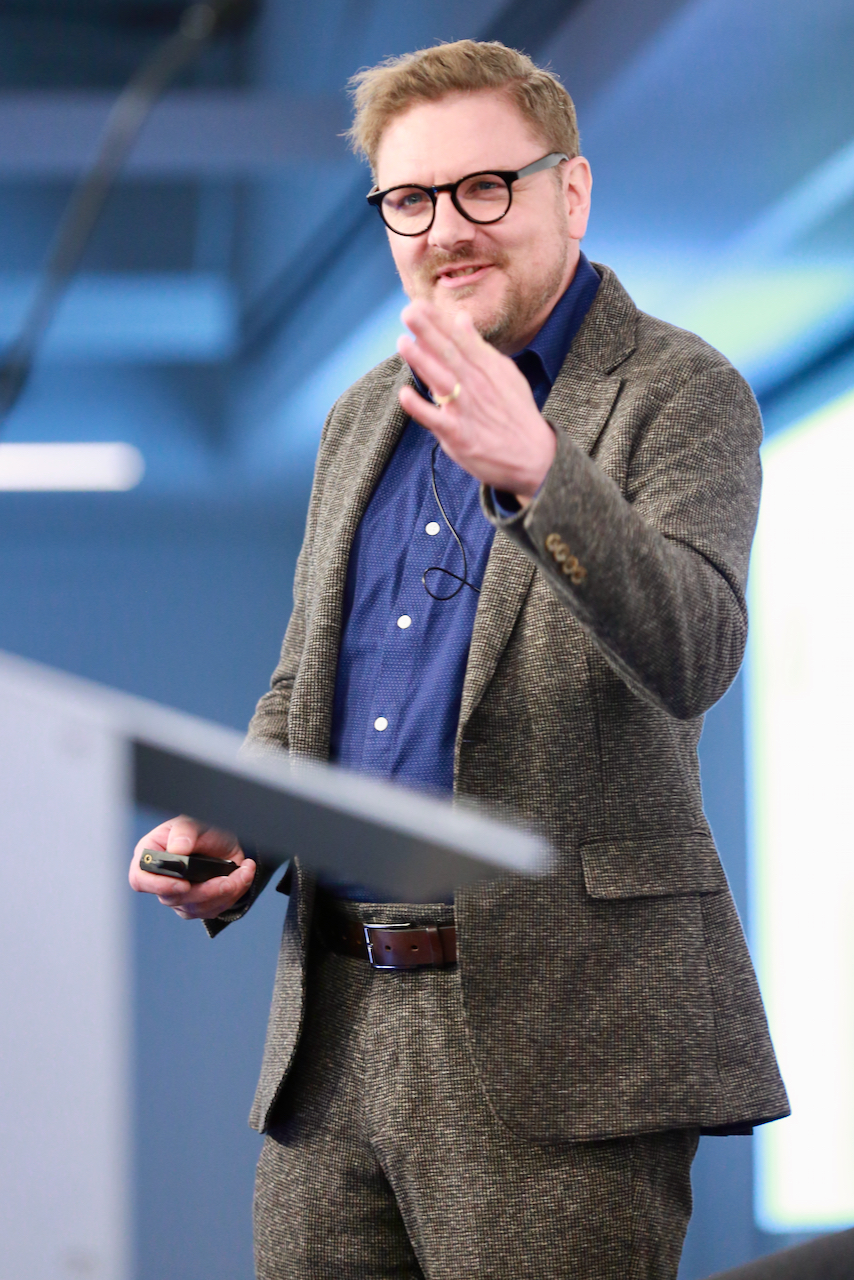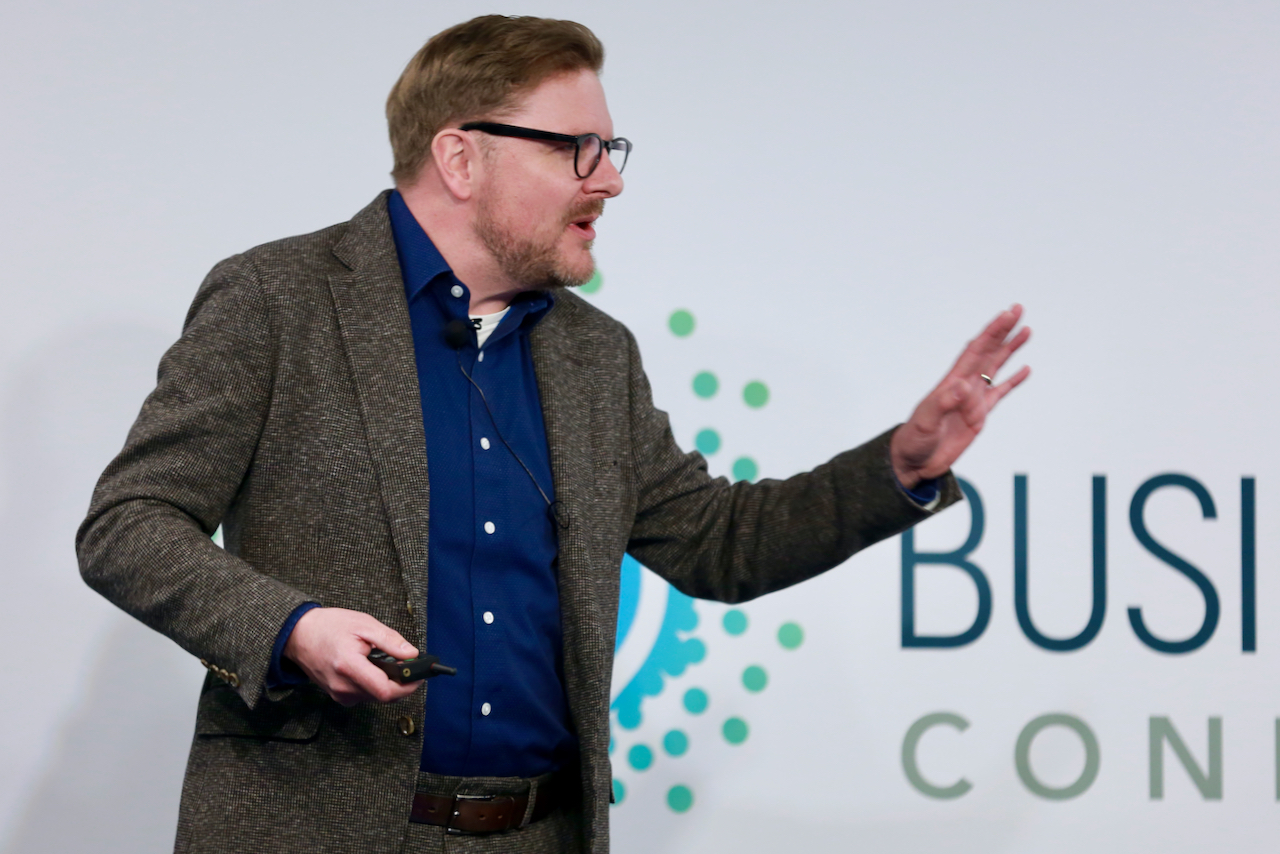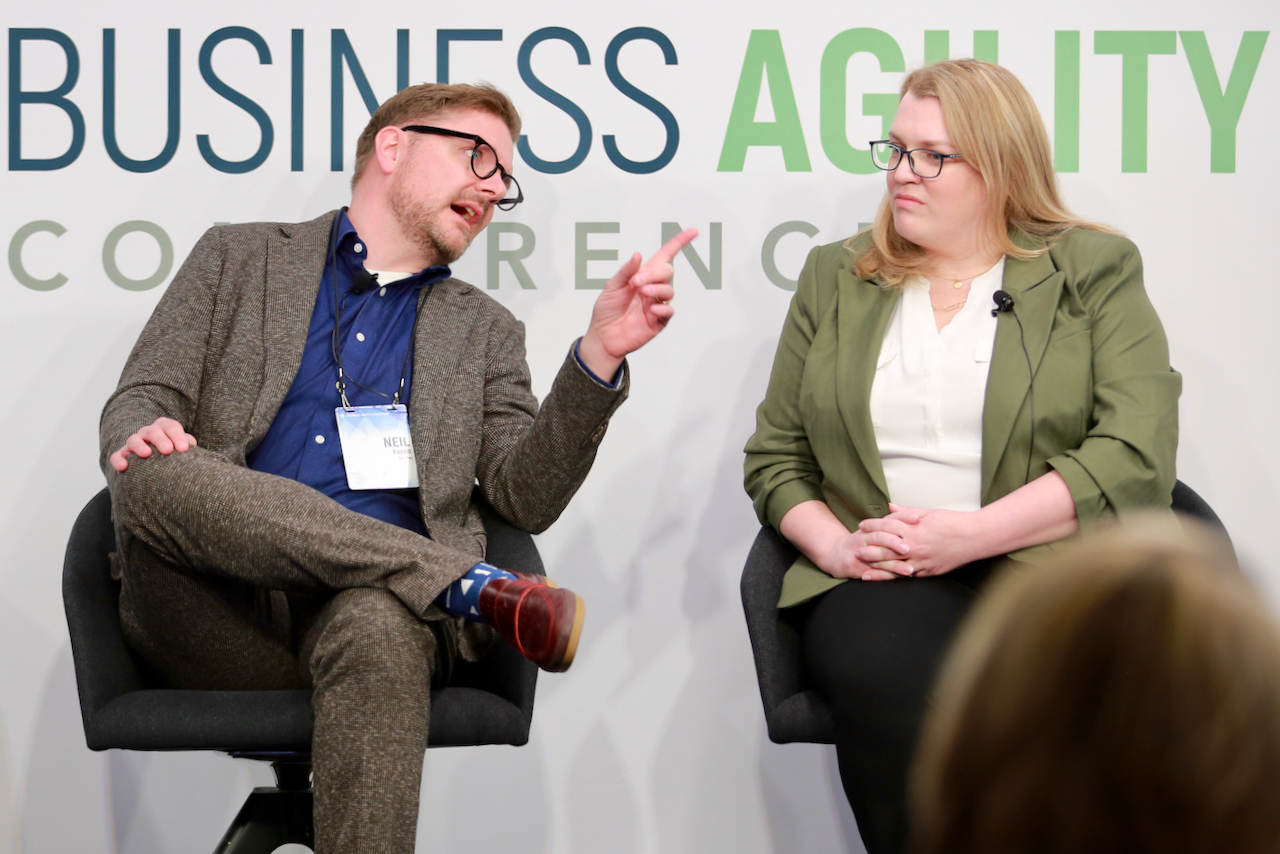All right, well, I'm here to talk to you all about resilience in the face of futility. And more specifically, I am going to talk about how to stay positive and motivated as a change agent. I'm going to share some of my stories and specifically, four tips I've learned that, maybe will be helpful for you. I guess you can tell me after the talk. So, it's kind of crazy for me to be here. I'll be honest with you. I live in Minnesota, which is a little different from New York. Thank you. And for those of you who are unfamiliar, this slide is actually a visual representation of Minnesota. It's really cold, it's generally covered in snow, and even without a pandemic, you really don't want to go outside. And up until today, this was the most exciting trip I had taken. This is me. I'm rolling out the compost, garbage and recycling to my alley, and it was fun. But New York is kind of another level for me, so I'm very excited to be here. So now you're probably saying, who the heck is this guy? Well, I am Neil Fasen, Senior Director of Product Practices for Best Buy. It's a technology retailer out of the United States, out of Minnesota. And through this job, I've had some really cool opportunities. I've had the privilege of establishing and supporting a group of amazing agile coaches. Those are the people I call the "shepherds of change" for the company. And I also had the opportunity to establish a product management community of practice. Where we try to evolve our ways of working and unlock, as Jon Smart would say, better value, sooner, safer, happier for the company. And you might also notice I am holding baritone ukulele in this picture. I fancy myself a creative character, and I also drew some of the pictures here to try to make it a little bit more lively, see if that works.
So, I don't need to tell you all, but change is hard, right? I mean, people don't like to change. Thinking back to the past two years, where we saw first-hand, trying to change behavior with a lot of people can go kind of sideways. People can be a little bit squirrely about it. And yet here all of us are at a Business Agility Conference. I'm guessing most, if not all of you, are driving change every day in your work. And are we out of our minds? Are we gluttons for punishment? Well, the answer is probably yes. And I also think that we believe a truth. A truth that we want to share. And that is that our ability to adapt and learn has really been that secret sauce over time as humans. Whether it was discovering fire, or building the steam engine, or Kid A by Radiohead. These amazing things have happened. And those discoveries have opened our minds to new things. And I think that probably excites a lot of us. And we want to share that with the companies that we support so that they can have more impactful outcomes. But it's not easy. So as promised, I am going to talk to you about four survival tips based on my own experiences. Things that I come back to and try to use as ways to stay motivated and resilient. So, I'll begin with tip one.
And I will start with the story of myself as a young, squeaky business person, or at least person attempting to be. And I got hired by a Fortune 50 company in Minneapolis, not Best Buy years before that, as a digital project manager. In hindsight, I probably was underqualified. I had worked in small companies, and I had a track record of getting things done, and I guess that was good enough to get my foot in the door. But I didn't know a Gantt chart from a cantaloupe. The Iron Triangle was like potentially a heavy metal band from the 80s that I had missed. I didn't really have the sort of foundational education to be successful. But I was there and I was trying to do a job. And I remember in one of my first projects, a supervisor said to me, "Neil, here's a bunch of scope. I need you to make a timeline and you have to stick the team to this timeline." I thought for a moment. I raised a hand and I said, "okay, how do I know what the team could do?" They're like, "oh, sweet, Neil, you innocent, boy. Yeah, it doesn't matter. You've got a timeline. You drive the timeline." I'm like, "okay, great". So as you can imagine, things went really badly. And after a few projects, I learned a lesson. Most of the people doing the work hated their job. I was ostensibly a guy with a clipboard that was barking, when "will it be done?" "When will it be done? Timeline, timeline." And before long, I was thinking back to my fond previous career as a barista. And while they didn't pay as well as corporate America, boy, it seemed less soul crushing to me. Just when I thought things were bound for oblivion, something happened. I discovered magic of agility. It was incredible. You see, there was a very fortuitous thing that happened to me.
That Fortune 50 retailer all of a sudden became interested in this fad. There was this thing called mobile, and they're like, "hey, you and these other rabble rousers, why don't you figure out how we might sell stuff on mobile? I don't care how you do it, just do it and it'll be gone in a couple of years and we'll see what you do then." And so, doing what I had learned to do in college, I sought out people smarter than myself. And we discovered people on the West Coast who blew our minds about these concepts like product management and agile values. And before long, we were building stuff and we were moving faster than our colleagues. And people started to get jealous. Like, how come the mobile team gets to release every other week? And we were just going. But then what I realized is, yeah, it was cool to build cool stuff and it was cool to move quickly. But the best thing was we all loved what we were doing. And that's when I realized my why. I want to create an environment where people can do their best work. And I want to do that because I've seen and experienced firsthand how that leads to the most impactful outcomes. And this concept is stuck with me in those moments where I'm rolling the rock up the hill and maybe banging my head against it and shrieking to the sky, "why do I do this?" I'm like, Neil, you want to create an environment where people can do their best work. Okay, so this is my survival tip one. In those moments when you're banging your head against the rock, that you're rolling up a hill and screaming to the heavens, why. Have an answer. My answer is I want to create an environment where people can do their best work. But what's your why?
Tip number two, I will talk about starting with the quote. There's a quote that says, "Software is easy, people are hard." Now, I attribute this to a smart friend of mine, but I think he might be ripping it off from somewhere. So if you're sitting there saying, Well, "Neil, that's Frock Borton Wilterson in his book", let me know. I just know my buddy says it. And this sticks with me. I think about this a lot. And I particularly thought about people being difficult when I was given the privilege at this Fortune 50 retailer of moving on to a high profile program. After a couple of years of the magic of Agility with this mobile team, I was suddenly rewarded to become part of this Behemoth, 400 people across the world, trying to do something. This grainy photograph was taken at some time around 06:30 a.m. Central you may not be able to tell because like a photo of Bigfoot or the Loch Nest monster, it is quite grainy. But that's me crumpled over in a cube holding a telephone receiver. I am enduring one of the most painful things I've ever experienced in my life. A program status report. And it was insane. There were hundreds of people across the globe. Nobody was aligned, nobody had any idea what was going on. But everything was lime green. It was incredible. And in that moment, I thought, people are hard. It doesn't have to be this hard. I thought we proved for the last couple of years you could... But I also realized that while people are hard, people can also be the key. Because in these dark moments, I had a few people that I knew. There was Alan, the hip startup guy, who I could exchange emails about product management with. There was Sarah, our social media guru, who was saying, "there can be a better way. Don't give up." And there was Ben, our UX guru, who had this amazing ability of distilling down these complex things into simple, usable concepts. And in these moments, when I'm head in hand, thinking again about becoming a barista again, I could reach out to those folks. And I had found my people. And these are people where, when the going got tough, I could accidentally advance my slides too quickly. But what it said on there was I could share challenges with them. I could vent safely. I could celebrate wins and ideas. And what was awesome about that, was not only that it gave me an outlet, but we started to build a coalition.
And you know what happened there? A brave officer stood up and said, "hey, you know what, it seems like we've been hemorrhaging money. But these nine people seem to get along. What if they turn this into a product team?" And lo and behold, one day we were empowered and we went from 400 people down to a core group of nine. We built it out a little bit further, and it became one of that company's most successful product experiences. And it shaped the next wave of transformation. So survival tip two. Don't go it alone. People are hard, but people can also be the key. Find your people, people that can celebrate and amplify your message.
Number three, starting with another quote. A former boss of mine showed up bright eyed and bushy tailed. Again, this was long before Best Buy. And he said, "if you're not feeling resistance, you're probably not changing anything." It was an appropriate quote. However, it was a badly timed quote because we had just gone for 18 months with no officer, no VP of Product at that company, and we were feeling a lot of resistance, and we were not seeing a lot of change. And it felt again like Sisyphus. We were continuously enduring that resistance. And I was tired. I was kind of sick of it. I'd been dancing around, doing the things that you do without somebody with positional, authority. I was influencing without authority. I was managing upward. I was rallying my peers. I was creating a vision. And people were like, yeah, Neil, that's cute. What's your level again? So, I was really really burnt out. And I was like, "what do I do?" So I started to think about Dolphins. I was part of a really hip crew at that time called The Agile Orchestrators. And maybe at a future talk, you can learn about them, but we would support one another. We were agents of change, and we would talk about, what we call the dolphin rule. And it was, you can dive down deep, but you've always got to come back up for air. We talked about that in regard to coaching. We would dive into a portfolio, but we were a small but nimble group. We'd be like, okay, we can teach them the practices, and maybe facilitate some ceremonies, but make sure you're coming back and looking at the culture and the system of work. And then I started to think about the dolphin rule as it pertained to energy. And I was like, "man, I've been down in the weeds of this company and all of its problems and all of its stuff, and I'm starting to get overwhelmed and stressed out." Maybe I need to come up for air and refill my cup. So, I blocked time. I was like, you know what? I'm going to start to get more engaged in the community. I started to go to Agile and Product Meetups locally. Which I hadn't done in a few years because I'd grown cocky and complacent. And suddenly I met other people, people outside my company. I found people who could inspire me in new ways. They could tell stories of other company challenges. And before long, I was lucky enough to stumble into this consortium of people from across the world and met brilliant people and was able to travel and see how their companies work. And before long, I wasn't as caught up in the minutiae of all my own complexities and my own corporate issues. My cup was filled, and I suddenly had new ideas. And that's when I came to tip three. Follow the dolphin rule. You can dive down into the weeds but always come back up for air.
The fourth tip is how I felt when I switched companies. As you can tell from the picture, I was very calm, composed, and knew exactly what to do. And I showed up in a new place after being at one place for over ten years and quickly became overwhelmed with all of the things that I saw that I should be doing. And then all of the things that other people thought that I should be doing. And pretty soon, all of the things of all of the things that I wanted to do and they wanted me to do. And they thought maybe I could or should do and I didn't really realize, left me not knowing where to start. It was like whac-a-mole. And again, I was very overwhelmed because all I could see was opportunity and I couldn't focus. So again, I decided to go to people smarter than I. I went to books this time. I really enjoy Dan and Chip Heath. They write a lot of books about behavior change. They got Made the Stick, a favorite of mine, and Switch is a great one. And one of the things that they talk about in Switch is this concept of focusing on the bright spots. And the notion behind this is, in times of change, look for those things that are working and amplify them. Lean into those things. So in my new environment, I tried to look around and thought, okay, of all the millions of things I could or should or maybe might be doing, what is valuable and where is there a bright spot? Well, I knew there was an opportunity around planning and alignment and I also knew that there was one portfolio, about 30 teams or so that were interested in trying something different. And they were actually excited. They showed up here was doing this work. So I worked with them and we're like, "what if we were to get together and rather than talk about all the delivery stuff that usually doesn't happen? What if we talked about what our objectives were. And maybe some of the measures for the next quarter. And people probably don't even know who we are.
So what if we wrote down why we exist, what we do here, and who we are?" We just put that one piece of paper and then we're like, how do we get people to see it? So we reserved this walkway. This is pre-pandemic, mind you, which was a thoroughfare across our big corporate campus. Everybody had to walk from one building to the other, had to pass through here. So we set them all up at tables, everybody with their one pagers. And we did what we call the planning fair. And lo and behold, people liked it. We started getting all this feedback like, I had no idea what the Gunculator team did. Now I understand. Teams started to learn about one another. Team started to surface things that maybe were duplicating what somebody else was doing. If we hadn't focused on that bright spot, we probably wouldn't have made much progress had we tried to tackle everything. Fast forward two years later. Now we've got about 260 teams that are following this outcome based cycle of quarterly planning. Our planning fair has taken many changes with the pandemic. We are continuously iterating on how to do that remotely, in a serendipitous and engaging way. But it's become sort of a cornerstone to our product alignment and planning processes. So again, this is all about starting from a bright spot. So stealing shamelessly from the Heath brothers. My tip four is to focus on the bright spots. Look at those areas where things are working and lean into them. So in summation, I have distilled down Neil's four survival tips of how to maintain resilience and motivation as a change agent. Number one, again, remember why you do this. For me, I want to create an environment where people can do their best work because I've experienced firsthand the power and the impact of that. Number two, don't go it alone. People can be hard but people can be the key. Find your people. Don't go it alone. Number three, follow the dolphin rule. You can always get into the weeds but come back up for air restore yourself. The stress of dealing with resistance continuously can wear you down. Re energize. And last but not least, shamelessly stolen from the Heath brothers, focus on the bright spots. Find those areas where there is engagement, where there's opportunity, where there's fertile soil. All right, well, I thank you very much for listening to me today. I'm happy to connect with you in person over LinkedIn or via slack and other digital channels. Enjoy your day.






